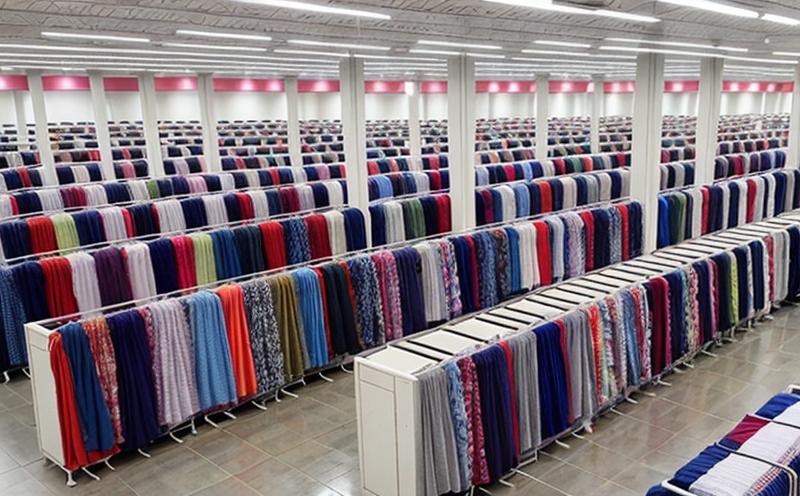ISO 6330 Domestic Washing and Drying Resistance Testing for Apparel Exports
The International Organization for Standardization (ISO) has published the standard ISO 6330 to address the challenges faced by textile exporters in ensuring that their apparel products maintain their appearance, fit, and functionality after domestic washing and drying. This standard is particularly critical for those exporting textiles to markets with varying water quality and detergent usage patterns.
Domestic washing and drying resistance testing ensures that garments retain their shape, colorfastness, and overall integrity through the typical domestic washing and drying cycles. Compliance with this test is especially important for exports destined for regions where consumer behavior regarding laundry practices can vary widely, affecting fabric durability over time. By adhering to ISO 6330, manufacturers and exporters can enhance product quality assurance, thereby building trust with importers and retailers.
The testing process involves subjecting samples of apparel to a series of domestic washing and drying cycles under specified conditions. These conditions are designed to mimic real-world usage scenarios as closely as possible. The standard specifies the temperature, duration, cycle type (e.g., normal wash or heavy duty), and the use of detergents that are representative of common household practices.
After the test, evaluators assess various aspects including colorfastness, shrinkage, dimensional stability, and overall appearance. Compliance is determined based on these criteria, ensuring that the products meet international quality standards. This testing not only helps in maintaining product integrity but also ensures that the garments remain suitable for their intended use after multiple washings.
The importance of ISO 6330 compliance extends beyond mere regulatory requirements; it enhances brand reputation and customer satisfaction by demonstrating a commitment to quality and reliability. Exporters who adhere to this standard can expect increased market access, better product acceptance, and higher sales volumes in competitive markets.
- Ensures consistent quality across multiple washing cycles
- Promotes durability of garments under real-world conditions
- Enhances brand reputation and customer trust
- Aids in meeting international standards for textile products
In summary, ISO 6330 testing is a cornerstone of quality assurance for apparel exporters. By following this standard, manufacturers can ensure that their products not only meet but exceed the expectations of consumers worldwide.
Why It Matters
The significance of ISO 6330 testing cannot be overstated for apparel exporters. The standard plays a pivotal role in safeguarding consumer satisfaction and brand reputation by ensuring that exported garments retain their quality throughout domestic washing and drying cycles.
Consumer expectations are high, especially when it comes to the durability and appearance of textiles after multiple washings. Non-compliance with ISO 6330 can lead to a range of issues, from customer dissatisfaction due to premature fabric degradation to potential legal repercussions for non-conformance. By adhering to this standard, exporters demonstrate their commitment to quality, which is crucial in building long-term relationships with importers and retailers.
Moreover, the standard helps in identifying any potential weaknesses in product design or manufacturing processes early on. This proactive approach allows manufacturers to address issues before they impact customer satisfaction negatively. In an increasingly competitive market, maintaining high standards of quality can be a significant differentiator for exporters.
The standard also ensures that exported products are suitable for the intended use and cultural context of the importing countries. Understanding these nuances is vital given the diverse laundry practices around the world. Compliance with ISO 6330 helps in creating products that not only meet but exceed local expectations, thereby enhancing market acceptance.
By prioritizing compliance with this standard, exporters can mitigate risks associated with non-conformance and benefit from enhanced brand reputation and increased sales volumes.
Applied Standards
The ISO 6330 standard is widely recognized for its comprehensive approach to domestic washing and drying resistance testing. This standard provides a framework that ensures consistency in the evaluation of textile products' performance under typical domestic washing conditions.
ISO 6330 specifies detailed procedures, including the types of wash cycles (normal or heavy), water temperatures, detergent usage, and rinse times. These parameters are designed to simulate real-world laundry practices, making the test results highly relevant for actual consumer use. The standard also includes criteria for evaluating colorfastness, shrinkage, dimensional stability, and overall appearance after washing.
The testing protocol is robust enough to identify any issues that could arise from poor quality control during manufacturing or design flaws in the product itself. By adhering to this standard, exporters can ensure that their products meet international standards and are suitable for various markets worldwide.
Furthermore, ISO 6330 encourages continuous improvement by providing a benchmark against which manufacturers can assess their processes. This helps in identifying areas where improvements can be made to enhance product quality further. The standard is continuously updated to reflect the latest developments in laundry technology and consumer expectations, ensuring its relevance remains high.
In summary, ISO 6330 is an essential tool for exporters looking to maintain a high level of quality assurance across their products. Its comprehensive approach ensures that exported textiles are not only durable but also meet the diverse needs of consumers around the world.
Why Choose This Test
- Promotes Consistency: Ensures consistent performance across multiple wash cycles, enhancing product reliability.
- Enhances Durability: Guarantees that the garment maintains its integrity and appearance over time.
- Builds Reputation: Demonstrates commitment to quality, thereby strengthening brand reputation and customer trust.
- Increases Market Access: Meets international standards, facilitating easier market entry in competitive environments.
- Precise Evaluation: Provides detailed evaluation metrics for colorfastness, shrinkage, dimensional stability, and appearance.
- Competitive Advantage: Differentiates products by ensuring superior performance under real-world conditions.
Selecting ISO 6330 testing ensures that your apparel products are not only compliant with international standards but also meet the high expectations of consumers worldwide. This commitment to quality can significantly impact market acceptance and customer satisfaction, giving you a competitive edge in the global market.





